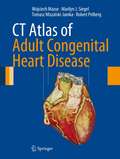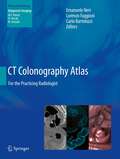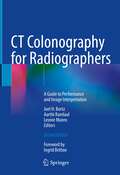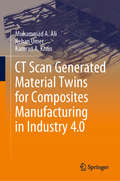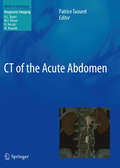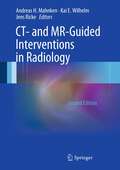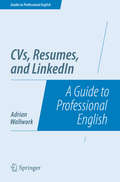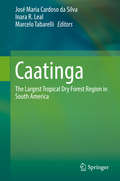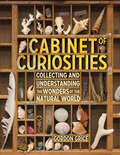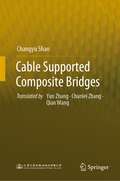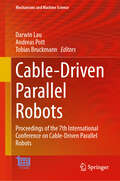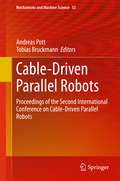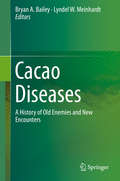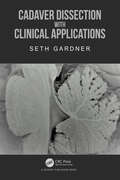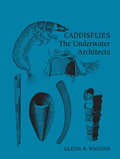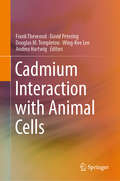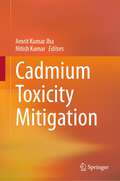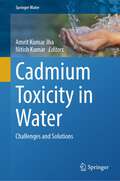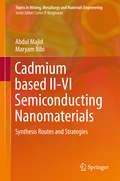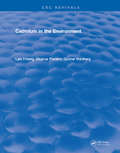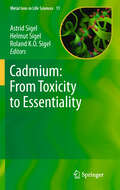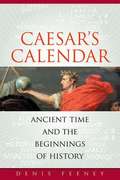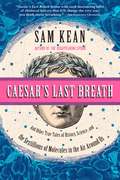- Table View
- List View
CT Atlas of Adult Congenital Heart Disease
by Robert Pelberg Wojciech Mazur Marilyn J. Siegel Tomasz Miszalski-JamkaThe aims and scope of this atlas include a complete review of the embryology of the normal heart, the normal cardiac anatomy along with a complete discussion of the terms and definitions used to identify and clarify both normal and abnormal anatomy. In addition, techniques of cardiac CT angiography as it pertains to imaging congenital abnormalities are discussed including radiation concepts and radiation saving techniques. The bulk of this book then goes on to completely review the field of adult congenital heart disease using text and more importantly a multitude of pictorial examples (in color and grey scale) to demonstrate the abnormalities. Drawings accompany each picture to better explain the example. Furthermore, difficult and complex anatomical examples are supplemented with digital images and movies to aid in illustrating and understanding the anatomy. Each general set of anomalies as well as each specific abnormality or set of abnormalities includes a concise and simple review of the embryology and epidemiology of the abnormality as well as a concise explanation of the anatomy of the abnormality. In addition, the methods to identify and recognize the abnormality by computed tomography is discussed. Finally, the prognosis and common treatment options for the anomaly are addressed within this comprehensive book.
CT Colonography Atlas: For the Practicing Radiologist (Medical Radiology)
by Emanuele Neri Carlo Bartolozzi Lorenzo FaggioniThis easy-to-use atlas comprises a collection of representative common and unusual virtual colonoscopy (CT colonography, CTC) cases that physicians and radiologists may expect to encounter during their clinical practice. The atlas reflects the important recent advances in image acquisition, patient preparation, and image processing and is thus completely up-to-date. Each case is presented with the native CT images, integrated images obtained by 3D image processing, and colonoscopic correlation. Topics covered include normal appearances, anatomical variants, pitfalls, diverticula, lipomas, inflammatory bowel disease, polyps, flat lesions, cancers, and the postsurgical colon. By presenting the main features of anatomy and pathology, this atlas will serve as an invaluable tool both for radiologists performing CTC and for clinicians who need to review the CTC examinations of their patients.
CT Colonography for Radiographers: A Guide to Performance and Image Interpretation
by Joel H. Bortz Aarthi Ramlaul Leonie MunroThis second edition, comprising 28 chapters, explains every aspect of the role of radiographers in performing CT colonography (CTC) and interpreting CTC images with the aim of enabling radiographers to extend the scope of their practice. It provides information required with respect to communication with the patient, procurement of informed consent, the principles of CT as well as dual-energy CT and photon counting CT, radiation dose, patient preparation and positioning, the use of contrast media, the performance of diagnostic and screening CTC studies, the interpretation and reporting of images, legal and professional requirements, and the importance of clinical audits.A wide range of CTC findings is described and depicted, covering normal anatomy, artefacts, haemorrhoids, polyps, colon cancer, diverticular disease, lipomas, extracolonic structures, opportunistic screening for osteoporosis and metabolic associated fatty disease, and CTC in incomplete or failed colonoscopy. The role of other modalities such as ultrasound, magnetic resonance imaging, and nuclear medicine in colorectal cancer patients is discussed. In addition, the text covers the role of artificial intelligence and machine learning in imaging of the colon for the detection of polyps, diagnosis and staging of colorectal cancer. Lastly, a chapter focusing on self-assessment of image interpretation will aid learning.This book provides the support that radiographers need in order to perform CTC studies to the standard required in terms of advances in imaging and interpretation of images.
CT Scan Generated Material Twins for Composites Manufacturing in Industry 4.0
by Muhammad A. Ali Rehan Umer Kamran A. KhanThis book highlights a novel and robust platform in the form of in-situ characterization setup for creating X-ray computed tomography (XCT)-based textile material twins. In this hybrid experimental–numerical platform, XCT images of different complex fibrous reinforcements at different levels of compaction are acquired. The images are converted into computational models for resin flow simulations. The capabilities of this hybrid framework are applied to a variety of reinforcements used in liquid composite molding processes such as 2D, 3D fabrics and dry tapes. This book is a milestone in the development of virtual manufacturing protocols using material twins of textiles, providing a step closer to the digitalization of advanced composites used in manufacturing processes for industry 4.0.
CT of the Acute Abdomen (Medical Radiology)
by Patrice TaourelCT of the Acute Abdomen provides a comprehensive account of the use of CT in patients with acute abdomen. Recent important developments in CT, including multislice CT and multiplanar reconstructions, receive particular attention. CT features are clearly illustrated, and pitfalls and differential diagnoses are discussed. The first section of the book presents epidemiological and clinical data in acute abdomen. The second and third sections document the key CT findings and their significance and discuss the technological background. The fourth and fifth sections, which form the main body of the book, examine in detail the various clinical applications of CT in nontraumatic and traumatic acute abdomen. This book will serve as an ideal guide to the performance and interpretation of CT in the setting of the acute abdomen; it will be of value to all general and gastrointestinal radiologists, as well as emergency room physicians and gastrointestinal surgeons.
CT- and MR-Guided Interventions in Radiology
by Andreas H. Mahnken Jens Ricke Kai E. WilhelmInterventional radiology is an indispensable and still expanding area of modern medicine that encompasses numerous diagnostic and therapeutic procedures. The revised and extended second edition of this volume covers a broad range of non-vascular interventions guided by CT or MR imaging. Indications, materials, techniques, and results are all carefully discussed. A particularly comprehensive section is devoted to interventional oncology as the most rapidly growing branch of interventional radiology. In addition, detailed information is provided that will assist in establishing and developing an interventional service. This richly illustrated book will be a most valuable source of information and guidance for all radiologists who deal with non-vascular procedures.
CVs, Resumes, and LinkedIn: A Guide to Professional English (Guides to Professional English)
by Adrian WallworkAre you a graduate, postgraduate or PhD student? Are you simply looking for a new job in the private or public sector, in research or industry? If your aim is to produce a professional CV or resume, then this book is for you. Based on interviews with recruiters and HR managers, and an analysis of hundreds of CVs from around 40 different countries, the book is structured as a series of FAQs.Topics covered include:how recruiters and HR people analyse a CVwhether using a template is a good ideathe difference between a CV and a resumehow to present your personal details and whether to include a photohow to write an Executive Summarywhat to write in each section (Education, Work Experience, Skills, Personal Interests)how to write dateshow to highlight your language, communication and team skillshow to get and write referencesYou will also learn some hints and strategies for writing a:cover letterLinkedIn profilereference letterbioThe last chapter of the book contains a simple template to help you get the job of your dreams!
Caatinga: The Largest Tropical Dry Forest Region in South America
by José Maria Cardoso da Silva Inara R. Leal Marcelo TabarelliThis book provides in-depth information on Caatinga's geographical boundaries and ecological systems, including plants, insects, fishes, amphibians, reptiles, birds, and mammals. It also discusses the major threats to the region's socio-ecological systems and includes chapters on climate change and fast and large-scale land-use changes, as well as slow and small-scale changes, also known as chronic human disturbances. Subsequent chapters address sustainable agriculture, conservation systems, and sustainable development. Lastly, the book proposes 10 major actions that could enable the transformation of Caatinga into a place where people and nature can thrive together. "I consider this book an excellent example of how scientists worldwide can mobilize their efforts to propose sound solutions for one of the biggest challenges of modern times, i. e. , how to protect the world's natural ecosystems while improving human well-being. I am sure this book will inspire more research and conservation action in the region and perhaps encourage other groups of scientists to produce similar syntheses about their regions. " Russell Mittermeier, Ph. D. Executive Vice-Chair, Conservation International
Cabinet of Curiosities: Collecting and Understanding the Wonders of the Natural World
by Gordon GriceExactly the book for every young explorer who loves finding stuff in nature and bringing it home. Cabinet of Curiosities is a lavishly illustrated introduction to the wonders of natural history and the joys of being an amateur scientist and collector. Nature writer Gordon Grice, who started his first cabinet of curiosities at age six when he found a skunk’s skull, explains how scientists classify all living things through the Linnaeus system; how to tell real gold from fool’s gold; how to preserve butterflies, crab shells, feathers, a robin’s egg, spider specimens, and honeycombs; how to identify seashells; the difference between antlers and horns; how to read animal tracks. And then, what to do with your specimens, including how to build a cabinet of curiosities out of common household objects, like a desk organizer or a box for fishing tackle.
Cable Stayed Bridges: From Concept to Performance-based Design
by Ayman ShamaCable stayed bridges are seen as the alternative that fills the gap between long span bridges and suspension bridges. During the 1980s, several types of construction of cable stayed bridges such as steel, segmental concrete, composite steel and concrete superstructures emerged in different countries. The great evolution in computational methods, materials, and methods of construction has contributed to the tremendous development in state of the art cable stayed bridges in the past two decades. With spans that exceed one thousand meters, cable stayed bridges are now becoming a substitute for suspension bridges. This book outlines the development in the design of cable stayed bridges. Rigorous methods of analysis are presented. Simplified methods that lead to preliminary estimation of forces in major members for design are discussed. The book first reviews the evolution of this type of bridge, with focus on the vast development during the past twenty years. The book then discusses the basic principles of cable stayed bridges, related to aspects of analysis, design, construction, and maintenance. Specific issues such as aerodynamic stability of the bridges and different methods of testing and analysis required for this purpose are explained. Cable vibration problems are summarized and methods of its control are outlined. Special attention is given to the performance-based design method and one chapter is devoted towards explanation of the merits of this trend in design. Application of the method to the seismic and fire safety designs of cable stayed bridges is also covered.
Cable Supported Composite Bridges
by Changyu ShaoThis book introduces the latest developments in long-span cable-supported composite cable-stayed bridges, suspension bridges, and mid- and through-type cable-supported composite arch bridges. Based on the engineering application and practice of cable-supported composite bridges, this book systematically expounds the structural systems of these bridge types. It also summarizes the main construction methods, analyzes the mechanical properties of cable-stayed bridges and suspension bridges with composite girders and the influence rule with alternative spans, and proposes the reasonable span range based on economic efficiency. The prospect of using orthotropic composite bridge decks in long-span cable-supported bridges is also analyzed. This book is a valuable reference for both bridge professional technicians and graduate students for research, design and construction.
Cable-Driven Parallel Robots: Proceedings of the 7th International Conference on Cable-Driven Parallel Robots (Mechanisms and Machine Science #182)
by Andreas Pott Tobias Bruckmann Darwin LauThis volume gathers the latest advances, innovations and applications in the field of cable robots, as presented by leading international researchers and engineers at the 7th International Conference on Cable-Driven Parallel Robots (CableCon), held in Hong Kong on July 8-11, 2025. It covers the theory and applications of cable-driven parallel robots, including their classification, kinematics and singularity analysis, workspace, statics and dynamics, cable modeling and technologies, control and calibration, design methodologies, hardware development, experimental evaluation and prototypes, as well as application reports and new application concepts. The contributions, which were selected through a rigorous international peer-review process, share exciting ideas that will spur novel research directions and foster new multidisciplinary collaborations.
Cable-Driven Parallel Robots: Proceedings of the Second International Conference on Cable-Driven Parallel Robots (Mechanisms and Machine Science #32)
by Andreas Pott Tobias BruckmannThis volume presents the outcome of the second forum to cable-driven parallel robots, bringing the cable robot community together. It shows the new ideas of the active researchers developing cable-driven robots. The book presents the state of the art, including both summarizing contributions as well as latest research and future options. The book cover all topics which are essential for cable-driven robots: Classification Kinematics, Workspace and Singularity Analysis Statics and Dynamics Cable Modeling Control and Calibration Design Methodology Hardware Development Experimental Evaluation Prototypes, Application Reports and new Application concepts.
Cacao Diseases: A History of Old Enemies and New Encounters
by Bryan A. Bailey Lyndel W. MeinhardtThis book reviews the current state of knowledge concerning cacao pathogens and methods for their management. Topics discussed include the history, biology and genetic diversity of Moniliophthora (which causes witches' broom and frosty pod rot) and Phytophthora species (which causes black pod rot) that cause diseases resulting in major losses to cacao production. Emerging pathogens such as Cacao swollen shoot virus and Ceratobasidium theobromae (which causes vascular streak dieback) are also discussed in detail, along with many pathogens of significant local concern. Most of these pathogens represent major risks to global cacao production should they expand into new areas, breaking out of their current limited distributions. By considering cacao diseases as a group, similarities in the available tools and techniques used in their management become apparent, as do their limitations. Gaps in our current knowledge of cacao pathogens and the management of the diseases they cause are detailed, and suggestions for future research directions are provided. This insight allows readers to consider cacao disease threats from a more comprehensive, global perspective and paves the way for an improved synergy of efforts between the various research programs, agencies, and industries, both private and public, with vested interests in cacao production, and cacao farmers.
Cadaver Dissection with Clinical Applications
by Seth GardnerCadaver Dissection with Clinical Applications is written for students in a professional program that have been given the privilege of dissecting their own cadaver. It discusses dissection techniques, what structures to look for in a particular region and various pitfalls to avoid in the process. The Manual also relates regional anatomical structures with clinical relevance by listing various syndromes, relevant orthopaedic tests, selected X-ray findings and associated pathologies that relate to the region being dissected. It is a terrific resource for all students who will one day see patients in a clinical setting, by first learning anatomical relevance on a cadaver.
Caddisflies
by Glenn B. WigginsCaddisflies constitute the insect order Trichoptera in which some 10,000 species are known in the world, including about 1400 in North America. Fossil evidence shows that caddisflies originated in the Triassic period, 200-250 million years ago. They are important links in the movement of energy and nutrients through freshwater ecosystems due largely to the extraordinary diversification in their larval architecture, which includes portable and stationary shelters, silken filter nets, and osmotically semipermeable cocoons. Glenn Wiggins's Caddisflies is the foremost comprehensive reference source about these insects and is concerned with behavioural ecology, evolutionary history, biogeography, and biological diversity.Wiggins outlines fundamental concepts of aquatic ecology, illuminating the ways in which caddisflies help to make fresh waters work. Essential features of morphology, biology, and distribution are outlined for the twenty-six North American families of caddisflies and illustrated diagnostic keys are provided for larvae, pupae, and adults. The author also brings together information on caddisflies from widely scattered sources and provides comprehensive coverage of the scientific literature.
Cadmium Interaction with Animal Cells (Springerbriefs In Molecular Science)
by Andrea Hartwig Frank Thévenod David Petering Douglas M. Templeton Wing-Kee LeeThis book outlines the interaction of cadmium with the proteome and signalling molecules of mammalian cells. Chapters from expert contributors cover topics such as cadmium chemical biology, membrane receptors and transporters for cadmium and cadmium complexes, and targets of cadmium toxicity. Students and researchers working in bioinorganic chemistry will find this book an important account.
Cadmium Toxicity Mitigation
by Nitish Kumar Amrit Kumar JhaThis book covers cadmium contamination of soil and plants, its sources, acute and long-term impacts on the environment and human health, and overall challenges posed by the global poisoning issue. Cadmium is among the elements that have been most broadly used by man over time, which has led to extensive pollution of surface soils, mainly associated with the mining and smelting of the metal and the addition of organic cadmium compounds to petrol. The release of cadmium into the atmosphere from various high-temperature processes has also led to surface contamination on a regional and even global scale. Cadmium is particularly firmly bound to humic matter in organic-rich soil and to iron oxides in mineral soil and is rather immobile in the soil unless present at very high concentrations. Plants grown on cadmium-rich soils incorporate cadmium, thus increasing the concentration of cadmium in crop plants. Cadmium thus enters the food chain through the consumption of plant material, which poses important health risks to humans and animals. In this book, readers will find out about the latest mitigation strategies, including a multi-disciplinary approach to address cadmium contamination. Recent methods in cadmium detoxification, speciation, and molecular mechanisms are included, and the book offers the knowledge required for efficient risk assessment, prevention, and countermeasure. Divided into 3 parts, this book brings together expert contributions on cadmium toxicity. In the first part, readers will find out about the different sources and distribution of cadmium in soil and plant ecosystems. The second part of the book outlines the health risks linked to cadmium toxicity, and in the final part, readers will discover sustainable cadmium toxicity mitigation strategies and potential applications of recent biological technology in providing solutions. This book is a valuable resource for students, academics, researchers, and environmental professionals doing fieldwork on cadmium contamination throughout the world.
Cadmium Toxicity in Water: Challenges and Solutions (Springer Water)
by Nitish Kumar Amrit Kumar JhaThis book sheds light on this global environmental issue and proposes solutions to reduce contamination through multi-disciplinary approaches. Water is considered a vital resource because it is necessary for all aspects of human and ecosystem survival. However, due to natural processes and anthropogenic activities, various pollutants have been added to the groundwater system. Among these, heavy metals are some of the most serious pollutants. Cd, a toxic heavy metal used in Ni-Cd batteries, the coloration of plastic and various discarded electronic products released into the water system causes serious health issues. The chronic exposure to Cd produces a wide variety of acute and chronic effects in humans.This edited book brings together a diverse group of researchers to address the challenges posed by global mass poisoning caused by cadmium contamination of water bodies. This book contains three sections. The first section describes the different sources and distribution of cadmium in water ecosystem. The second section explains the health risks linked to cadmium toxicity. The third section addresses sustainable cadmium toxicity mitigation strategies and the potential applications of recent biological technology in providing solutions.
Cadmium Toxicity: Challenges and Solutions
by Nitish KumarThis book offers a comprehensive collection of review and case chapters that cover cadmium toxicity and remediation. It covers sources of cadmium contamination, its impact on human health, and prospective remediation strategies, taking a multi-disciplinary approach a focus on application of recent advanced biological technology. The chapters here bring together a diverse group of environmental science, sustainability and health researchers to address the challenges caused by cadmium contamination, explaining the routes of exposure to environmental cadmium, how cadmium is transported in ecosystems, and the health risks linked to cadmium exposure in food and the environment. This book contains two sections. The first section describes the different sources and distribution of cadmium in soil and plant ecosystems. The second section addresses sustainable cadmium toxicity mitigation strategies and potential applications of recent biological technology. This book is a valuable resource to students, academics, researchers, and environmental professionals studying cadmium contamination throughout the world.
Cadmium based II-VI Semiconducting Nanomaterials: Synthesis Routes and Strategies (Topics in Mining, Metallurgy and Materials Engineering)
by Abdul Majid Maryam BibiThis book provides technological perspective and comprehensive overview on the research efforts related to II-VI group cadmium based semiconducting nanomaterials. It describes state-of-the-art information on different synthesis methods for preparation of these materials using a variety of experimental strategies. The effects of synthesis roots on structural, thermal, mechanical, lattice vibronic, electronic, optical and carrier transport characteristics of these nano-structures are systematically analyzed. A wide target readership comprising of students, researchers, scholars, scientists, technicians, academicians, industrialists can benefit from this book, as cadmium based semiconductors possess significant research and industrial interest thanks to their innovative properties.
Cadmium in the Environment
by Lars FribergThe focus of this report is upon information essential to the understanding of the toxic action of cadmium and the relationship between dose (exposure) and effects on human beings and animals. The therapy of cadmium poisoning has not been discussed.This review on cadmium in the environment has been performed under a contract between the U.S. Environmental Protection Agency and the Department of Environmental Hygiene of the Karolinska Institute, Sweden. The report is intended to serve as a background paper for a future Air Quality Criteria document on cadmium. Therefore, particular attention has been given to information relevant for the evaluation of risks due to long-term exposure to low concentrations of cadmium. Acute effects from short-term exposure to high concentrations are dealt with briefly. In vitro studies without bearing on the main problem have not been dealt with.The report is not limited to effects from exposure via inhalation. Newly accessible information, showing that large populations may be exposed considerably via the oral route, can elucidate chronic effects of cadmium in general. Man and animals can be victims of secondary exposure through vehicles such as food and water which have been contaminated by cadmium in air.
Cadmium: From Toxicity To Essentiality (Metal Ions in Life Sciences #11)
by Astrid Sigel Roland Ko Sigel Helmut SigelVolume 11 provides in an authoritative and timely manner in 16 stimulating chapters, written by 40 internationally recognized experts from 11 nations, and supported by more than 2600 references, 35 tables, and over 100 illustrations, many in color, a most up-to-date view on the role of cadmium for life, presently a vibrant research area. MILS-11 covers the bioinorganic chemistry of Cd(II), its biogeochemistry, anthropogenic release into the environment, and speciation in the atmosphere, waters, soils, and sediments. The analytical tools for Cd determination, its imaging in cells, and the use of 113Cd NMR to probe Zn(II) and Ca(II) proteins are summarized, as are Cd(II) interactions with nucleotides, nucleic acids, amino acids, and proteins including metallothioneins. The phytoremediation by Cd(II)-accumulating plants, etc., the toxicology of Cd(II), its damage to mammalian organs, and its role as a carcinogen for humans, are highlighted.
Caesar's Calendar: Ancient Time and the Beginnings of History
by Denis FeeneyDenis Feeney investigates time and its contours as described by the ancient Romans, first as Rome positioned itself in relation to Greece and then as it exerted its influence as a major world power.
Caesar's Last Breath: Decoding the Secrets of the Air Around Us
by Sam KeanThe fascinating science and history of the air we breatheIt's invisible. It's ever-present. Without it, you would die in minutes. And it has an epic story to tell.In Caesar's Last Breath, New York Times bestselling author Sam Kean takes us on a journey through the periodic table, around the globe, and across time to tell the story of the air we breathe, which, it turns out, is also the story of earth and our existence on it.With every breath, you literally inhale the history of the world. On the ides of March, 44 BC, Julius Caesar died of stab wounds on the Senate floor, but the story of his last breath is still unfolding; in fact, you're probably inhaling some of it now. Of the sextillions of molecules entering or leaving your lungs at this moment, some might well bear traces of Cleopatra's perfumes, German mustard gas, particles exhaled by dinosaurs or emitted by atomic bombs, even remnants of stardust from the universe's creation.Tracing the origins and ingredients of our atmosphere, Kean reveals how the alchemy of air reshaped our continents, steered human progress, powered revolutions, and continues to influence everything we do. Along the way, we'll swim with radioactive pigs, witness the most important chemical reactions humans have discovered, and join the crowd at the Moulin Rouge for some of the crudest performance art of all time. Lively, witty, and filled with the astounding science of ordinary life, Caesar's Last Breath illuminates the science stories swirling around us every second.
